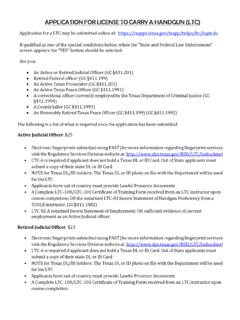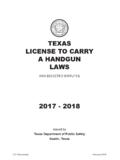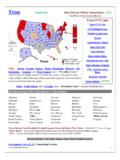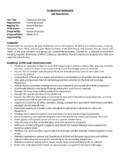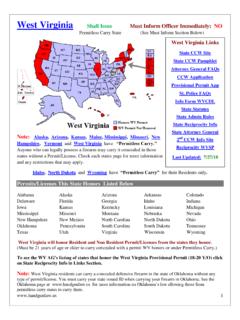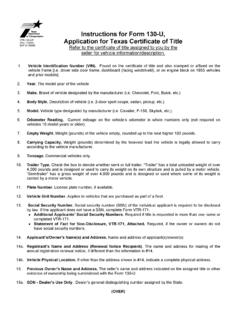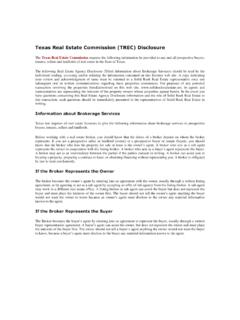Transcription of A-Law and mu-Law Companding Implementations Using …
1 A-Law and mu-LawCompandingImplementations Usingthe TMS320C54xApplication Note: SPRA163 ACharles W. Brokish, MTS Michele Lewis, MTSA SC Group Technical MarketingDigital Signal Processing Solutions December 1997 IMPORTANT NOTICE Texas Instruments (TI) reserves the right to make changes to its products or to discontinue anysemiconductor product or service without notice, and advises its customers to obtain the latest version ofrelevant information to verify, before placing orders, that the information being relied on is warrants performance of its semiconductor products and related software to the specifications applicableat the time of sale in accordance with TI s standard warranty.
2 Testing and other quality control techniquesare utilized to the extent TI deems necessary to support this warranty. Specific testing of all parameters ofeach device is not necessarily performed, except those mandated by government application Using semiconductor products may involve potential risks of death, personal injury, orsevere property or environmental damage ( Critical Applications ).TI SEMICONDUCTOR PRODUCTS ARE NOT DESIGNED, INTENDED, AUTHORIZED, OR WARRANTEDTO BE SUITABLE FOR USE IN LIFE-SUPPORT APPLICATIONS, DEVICES OR SYSTEMS OR OTHERCRITICAL of TI products in such applications is understood to be fully at the risk of the customer.
3 Use of TIproducts in such applications requires the written approval of an appropriate TI officer. Questions concerningpotential risk applications should be directed to TI through a local SC sales order to minimize risks associated with the customer s applications, adequate design and operatingsafeguards should be provided by the customer to minimize inherent or procedural assumes no liability for applications assistance, customer product design, software performance, orinfringement of patents or services described herein.
4 Nor does TI warrant or represent that any license,either express or implied, is granted under any patent right, copyright, mask work right, or other intellectualproperty right of TI covering or relating to any combination, machine, or process in which suchsemiconductor products or services might be or are 1997, Texas Instruments IncorporatedTRADEMARKS TI is a trademark of Texas Instruments brands and names are the property of their respective INFORMATION US TMS320 HOTLINE(281) 274-2320US TMS320 FAX(281) 274-2324US TMS320 BBS(281) 274-2323US TMS320 8 Human Acoustics and the Telephone Network.
5 8 Pulse Code Modulation and Companding .. 10 -Law 11A-Law Companding .. 14 implementation Using the 18 System Requirements vs. Coding Scheme .. 18 -law Compression .. 20 -law Expansion .. 22A-law 23A-law Expansion .. 25 Summary .. 26 Appendix A. Companding 27 Appendix B. Companding Code 31 Appendix C. References .. 36 FiguresFigure 1. Sample Speech Signal: GOAT .. 9 Figure 2. -law Companding 12 Figure 3. A-Law Companding Curve .. 15 TablesTable 1. -law Binary Encoding 13 Table 2. -law Binary Decoding 14 Table 3. A-Law Binary Encoding Table.
6 16 Table 4. A-Law Binary Decoding Table .. 17 Table 5. Companding Algorithms Summary .. 26 Table 6. -law Compression: .. 27 Table 7. -law Expansion: (shown in order as produced by compression table).. 28 Table 8. A-Law Compression .. 29 Table 9. A-Law Expansion (shown in order as produced by compression table) .. 30 A-Law and mu-Law Companding Implementations Using the TMS320C54x7A-Law and mu-Law CompandingImplementations Using theTMS320C54xAbstract Presented in this application note is the implementation of A-lawand -law Companding routines for the tms320c54x .
7 Theoreticalmaterial regarding Companding and speech signals is providedfirst, followed by thorough explanations of the algorithms. Finally,the code is benchmarked in terms of its speed and and mu-Law Companding Implementations Using the TMS320C54xIntroductionPresented in this section is a description of the components of aspeech signal and their influence upon the telephone system. Thetasks these components present to the telephone system may beachieved through the use of pulse code modulation andcompanding, also included in this Acoustics and the Telephone NetworkBy classifying according to their mode of excitation, speechsounds can be broken into three distinct classes of phonemes,where a phoneme is defined as the smallest unit of speech thatdistinguishes one utterance from another.
8 The three classes ofphonemes are voiced, unvoiced, and plosives. Voiced phonemesare considered deterministic in nature. They are produced byforcing air through the glottis with the tension of the vocal cordsadjusted so that they vibrate in a relaxed oscillation. Thisproduces quasi-periodic pulses of air which excite the vocal of voiced phonemes are the vowels, fricatives /v/, and/z/, and stop consonants /b/, /d/, and /g/. Unvoiced phonemes aregenerated by forming a constriction at some point in the vocaltract and forcing air through the constriction at a high enoughvelocity to produce turbulence.
9 As a result, unvoiced phonemesare considered random in nature. Examples of unvoicedphonemes are the nasal consonants /m/, and /n/, fricatives /f/, and/s/, and stop consonants /p/, /t/, and /k/. Similar in nature tounvoiced sounds, plosive sounds result from making a completeclosure of the vocal tract, building up pressure behind the closure,and abruptly releasing it, such as the /ch/ occurring speech signals are composed of combinationsof voiced, unvoiced and plosive phonemes. For example,contained in Figure 1 is the speech signal goat , which containstwo voiced phonemes /g/ and /oa/, followed by a partial closure ofthe vocal tract, and then an unvoiced phoneme, /t/.
10 The /g/, /oa/,and /t/ occur approximately at samples 3400-3900, 3900-5400,and 6300-6900, and mu-Law Companding Implementations Using the TMS320C54x9 Figure 1. Sample Speech Signal: GOATEach phoneme class brings its own stress to the telephonesystem. In general, the peak to peak amplitude of voicedphonemes is approximately ten times that of unvoiced and plosivephonemes, as clearly illustrated in Figure 1. As a result, thetelephone system must provide for a large range of signalamplitudes. Although lower in amplitude, unvoiced and plosivephonemes contain more information and thus, higher entropy thenvoiced phonemes.










